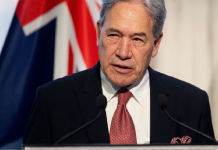DUBAI, United Arab Emirates (AP) — Iran is now producing uranium close to weapons-grade levels after the collapse of its nuclear deal with world powers, the installation complicates the West’s efforts to halt Tehran from potentially developing an atomic bomb as diplomacy over its nuclear program remains stalled.
Completion of such a facility “would be a nightmare scenario that risks igniting a new escalatory spiral,” warned Kelsey Davenport, the director of nonproliferation policy at the Washington-based Arms Control Association. “Given how close Iran is to a bomb, it has very little room to ratchet up its program without tripping U.S. and Israeli red lines. Further escalation at this point increases the risk of conflict. “
Construction on the Natanz site came five years after then-President Donald Trump unilaterally withdrew the United States from the nuclear deal. Trump said the deal did not include support for Iran’s ballistic missile program or militias across the Middle East.
But what they have done is to severely limit Iran’s uranium enrichment to 3.67% purity (enough to operate only civilian power plants) and its stockpile to just about 300 kilograms (660 pounds).
Iran has said it has enriched uranium by up to 60% since the end of the nuclear deal, but inspectors recently found that the country was producing uranium particles that were 83.7% pure. This is just a short distance from the 90 percent weapons-grade uranium content threshold. International inspectors said in February that Iran’s stockpile was more than 10 times larger than the stockpile under the Obama-era deal, enough to allow Iran to build “several” nuclear bombs, according to the director-general of the International Atomic Energy Agency. It was estimated that there was a large amount of enriched uranium.
President Joe Biden and the Prime Minister of Israel have said they will not allow Iran to build nuclear weapons. “While we believe diplomacy is the best way to achieve this goal, the President has also made it clear that no option is off the table,” the White House said in a statement to the Associated Press.
Although the Islamic Republic denies seeking nuclear weapons, Tehran officials are now openly debating its ability to do so.
In response to a question from the Associated Press, the Permanent Mission of Iran to the United Nations said, “Iran’s peaceful nuclear activities are transparent and subject to safeguards by the International Atomic Energy Agency.” have restricted. Iran has announced that the new construction will replace an above-ground centrifuge manufacturing center in Natanz, which was hit by an explosion and fire in July 2020. The Iranian government has blamed Israel for the incident. Israel has long been suspected of campaigning to thwart the plans.
Tehran has not confirmed further plans for the plant, but if it wants to import uranium into the country it will have to report its location to the IAEA. The Vienna-based IAEA did not respond to questions about the new underground facility.
The new project will be built near Natanz, about 225 kilometers (140 miles) south of Tehran. Natanz has become a point of international importance since its existence was made known 20 years ago.
The facility, protected by anti-aircraft batteries, fences and Iran’s militia Revolutionary Guard Corps, covers an area of 2.7 square kilometers on the country’s arid central plateau. A satellite image taken in April by Planet Labs PBC and analyzed by the Associated Press shows Iran drilling into Kue Kolan Gaz Lah (“Pickaxe Mountain”) just beyond the fence south of Natanz.Another image, analyzed by the James Martin Center for Non-Proliferation Studies, shows that the hillside has four entrances to him, two on the east and two on the west. Each measures 6 meters (20 feet) wide and 8 meters (26 feet) high.
The scale of the work can be measured by two large mounds of dirt to the west and one to the east. Experts at the center said Iran could build facilities between 80 meters (260 feet) and 100 meters (328 feet) deep, based on the size of the tail pile and other satellite data. It’s expensive, he told the Associated Press. The Center’s analysis is provided exclusively to AP and is the first time the depth of a tunnel system has been estimated based on satellite imagery.
The Institute for Science and International Security, a Washington-based nonprofit that has long worried about Iran’s nuclear programme, suggested last year that the tunnel could go deeper.
Experts believe the scale of the construction project indicates that Iran could potentially use the underground facility for uranium enrichment as well as for building centrifuges. These tubular centrifuges use dozens of machines arranged in a large cascade to rotate and enrich uranium gas. An additional cascade would allow Iran to rapidly enrich uranium under the protection of Mt. “So the depth of the facility is a concern because it makes it much more difficult for us to destroy. It would be much more difficult to destroy with conventional weapons such as the typical bunker buster bomb,” said the analysis of the tunnel construction.
The new Natanz facility is likely even deeper underground than Iran’s Ford facility, another enrichment facility discovered by US and other world leaders in 2009. The facility has raised concerns in the West that Iran will step up its airstrike program.






